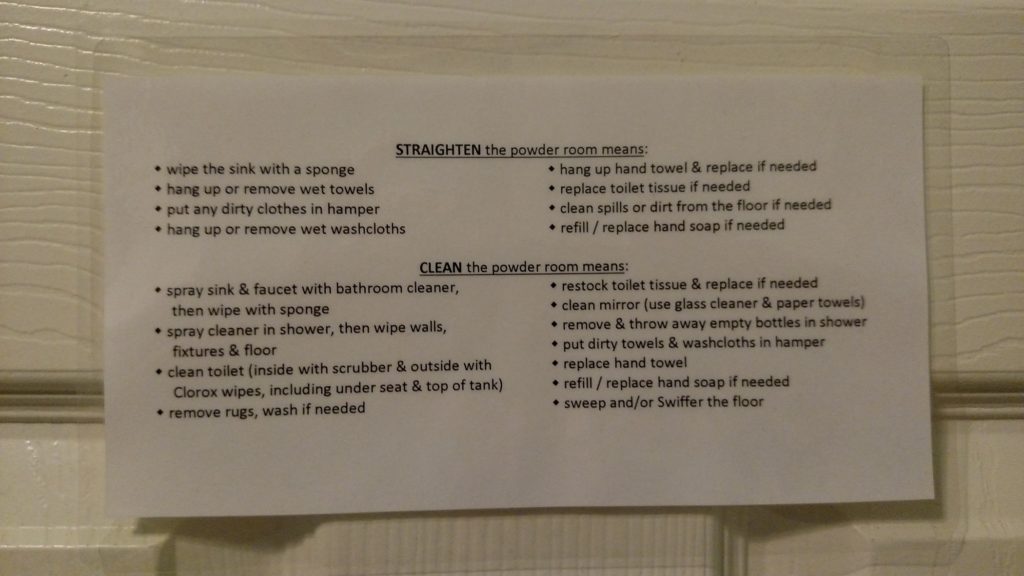Editor’s Note: Our monthly ‘Do It’ List has lots of the household duties covered
— and is a great task list as you think about delegating individual chores —
but how do you keep up with specific jobs assigned to each of your children?
In this #TBT post from 2017, Beth shares how her family has adopted a simple system
to help conquer the dreaded chore chart. We hope it will be helpful during the new year!
Any time we have adult guests in our home, they end up at the refrigerator.
They’re not rummaging in the depths for last week’s leftovers (or at least, I hope they aren’t). No, somehow they all end up looking at the same thing: our kids’ chore charts.
Males, females, young or older, even a few who aren’t parents yet, have all looked at our family’s chore charts. I’ve come to the conclusion that chores must be one of those things we adults never quite feel we’ve mastered. We might think things are going pretty smoothly, but there’s always the lingering suspicion that somebody out there has it figured out better than we have.
Over the years, I’ve tried—okay, I’ve looked at—a lot of different approaches, including some very elaborate systems. They’ve run the gamut: index card boxes, laminated tags on a metal ring, color-coded wall charts, emails telling me to stop whatever I was doing (how did they always know when I was nursing the baby?!?) and clean the kitchen sink.
And yes, we actually tried some of them.
A few never got off the ground at all. Those usually ended up in the next year’s used book sale. A couple worked well. For a while. But in the end, each one of them tanked. Either I felt like a failure for not keeping up, or it was such a burden I decided I might as well do ALL the work myself, as spend so much time and energy implementing The Perfect System.
It became, in short, a huge CHORE unto itself.
Allow me to pause and say one thing: I do realize chores are not just about my time. If it was just about my time, it would be faster to do almost any task myself than to teach a child to do it, supervise the work, check that it’s being done on a regular basis, and deal with discipline when/if it isn’t. But I get that chores teach self-discipline, responsibility, independence, life skills … there are a whole lot of crucial principles in the mix. Laura covered this pretty comprehensively when she wrote about teaching our children to work hard, and I absolutely agree that there’s something larger at stake than just my time.
Still, a so-called “organizational aid” that turns overseeing everyone else’s responsibilities into an administrative nightmare of Government-Office-of-Something-Or-Other proportions? No thanks. By the time I’m done color-coding and hole-punching six days of chores for four kids, I am WORN. FLAT. OUT. And that’s counterproductive because Mommy still has her own to-do list.
After many years of trial and error, we have settled into a routine at our house. One that, at long last, seems to work well for us.
Here’s how we approach chores:
- We assign age-appropriate responsibilities. The 8-year-old has household tasks, but they’re nowhere near as many or as complex as the ones we give her older siblings.
- One child has ownership of each job. That way, Person 2 doesn’t pay the price tomorrow if Person 1 neglects his/her chores or is gone today.
- Kids need to learn that maintaining a household requires consistent effort. One day per week is set aside for “cleaning” an area; the remaining days are “straightening.” We don’t let a whole week go by without addressing the mess.
- Each child has his/her own chore chart, with chores separated out by day. We print and laminate 2 copies; one goes on the refrigerator and another upstairs on a bulletin board near the kids’ bedrooms. That way, a list of their responsibilities is always handy and no one gets away with claiming, “I didn’t realize I was supposed to do _____ today.” Here’s an example:

- SPELL OUT what is expected. We first walk each child through any new task they’re being assigned, and supervise while they do it themselves. Then, there is a detailed, laminated list attached to the back of the door in each room that a child might be responsible for tidying. The list explains what CLEANING or STRAIGHTENING that room entails. So, for example, here’s what the list for our guest bathroom looks like:

- If a child displays weakness (or laziness) in a particular area, we’ll assign a chore that helps with that. Consistently leave your dirty plate on the table at our house, and you’ll most likely find yourself assigned to loading and unloading the dishwasher, and you’ll KEEP that chore until Mom and Dad are convinced you’ve learned to appreciate the work involved.
- At least twice per year, but sometimes as often as every 3-4 months, we reevaluate the lists in light of changes in the family, making adjustments for everyone’s schedule and reassigning chores so that our kids are learning to do different tasks.
- The punishment for neglecting chores is consistent. Our kids know that their responsibilities come before leisure activities like watching a movie or playing games. If work isn’t finished before play, we ground them from all leisure (except reading) until bedtime that day, for the first offense. If it happens again during the same week, they are grounded through bedtime Saturday.
- We work at keeping realistic expectations. If we had a hectic day and were out of the house for hours, obviously chores might suffer. We make allowances for that. If a child genuinely didn’t have time to finish her daily responsibilities, she won’t be grounded … but we do expect her to make up missed chores.
- REST: The children don’t have chores (to speak of) on Sunday. Pets still must be fed, and we do clear dishes from the table and load the dishwasher, but most other household work can wait.
- GRACE: No matter what happened the previous week, everyone starts with a clean slate on Monday.
I keep a list (usually in my head, occasionally on paper) of tasks that need to be done periodically, but aren’t on the regular chore rotation. Sometimes one of those extra chores is a consequence for a bad attitude or disobedience. Sometimes it’s an opportunity to earn extra spending money. And sometimes, our kids are given extra chores just because. Pitching in is part of being a family; it’s best our kids learn that sooner rather than later.
Granted, things do fall through the cracks. On occasion, a child gets careless. Other times, I’m the one guilty of failing to follow through. But we revise our lists, revisit each of our responsibilities, and get back on track … and we can do that without me beating myself up for failing with the $40 color-coded peel-and-stick chart that was supposed to Streamline the Whole Family’s Entire Existence in Five Easy Minutes Per Day.
It’s not The Perfect System, but it works for us. At the end of the day, I think that’s what every mom wants.
 Visit our sponsor to learn more about their excellent resources
Visit our sponsor to learn more about their excellent resources
for Spelling, Science, Guided Reading, and Handwriting.
